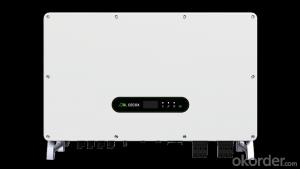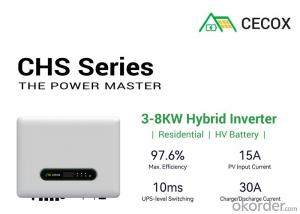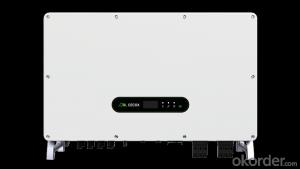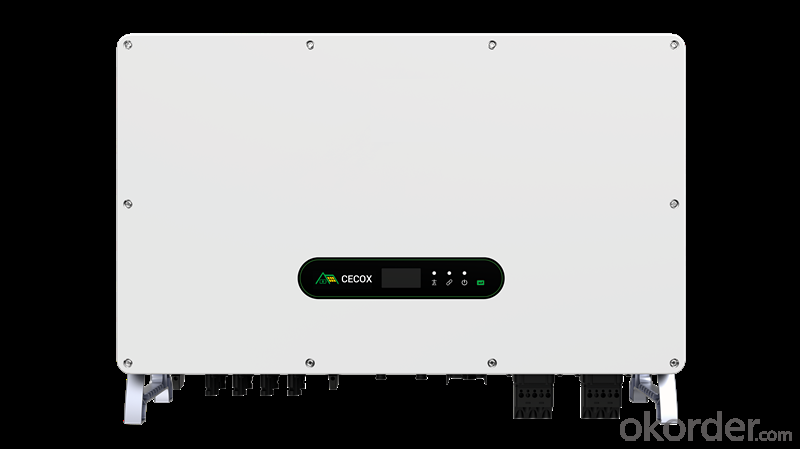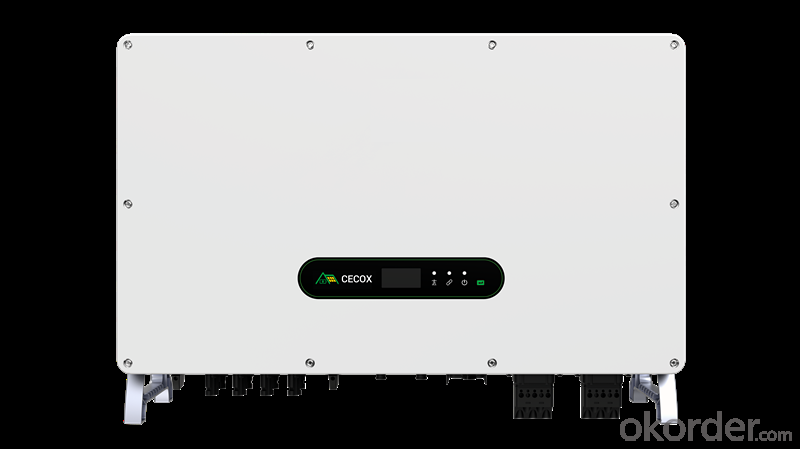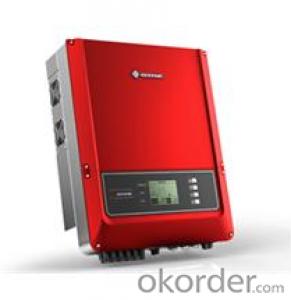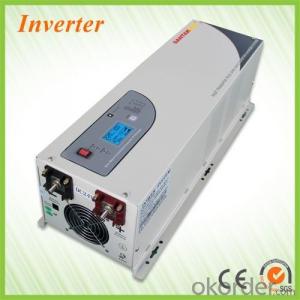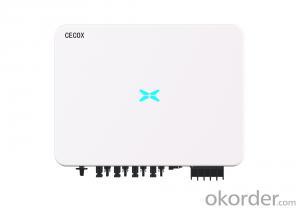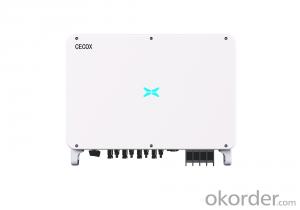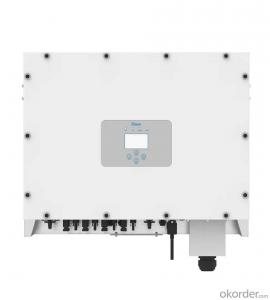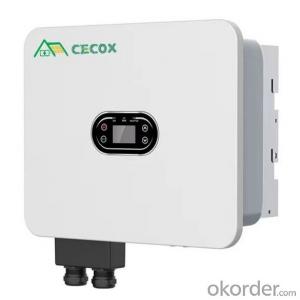Three Phase Solar 25kw 30kw 36kw 40kw50kw high voltage hybrid inverter Best Selling good price
- Loading Port:
- Stock in Panama
- Payment Terms:
- TT or LC
- Min Order Qty:
- 1 unit
- Supply Capability:
- 5000 unit/month
OKorder Service Pledge
Quality Product, Order Online Tracking, Timely Delivery
OKorder Financial Service
Credit Rating, Credit Services, Credit Purchasing
You Might Also Like
Specification
Output Power:
50kw
Inveter Efficiency:
98.8%
Output Voltage(V):
220/380v,230V/400V,240/415V
Input Voltage(V):
1000v
Output Current(A):
100A
Output Frequency:
50/60HZ
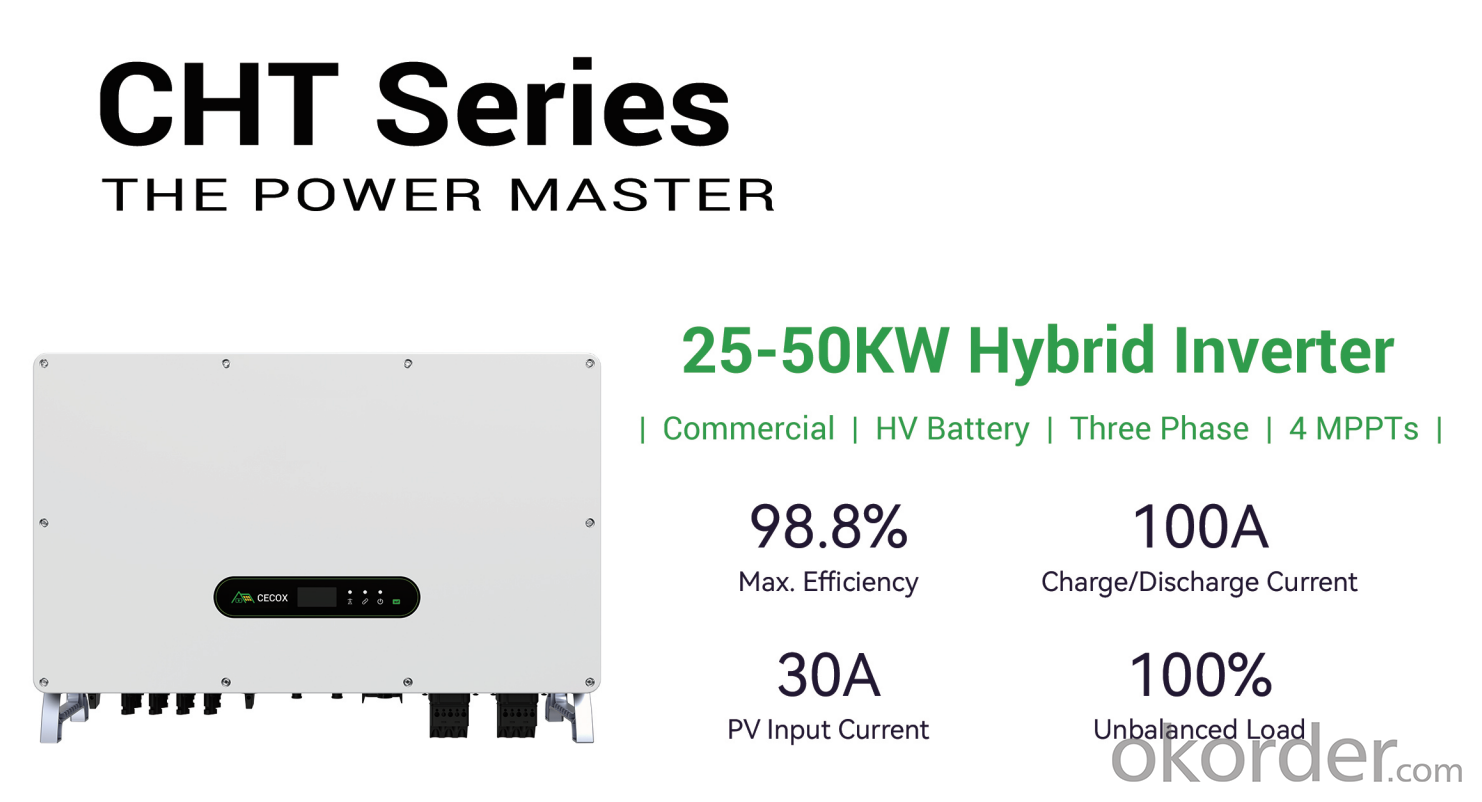
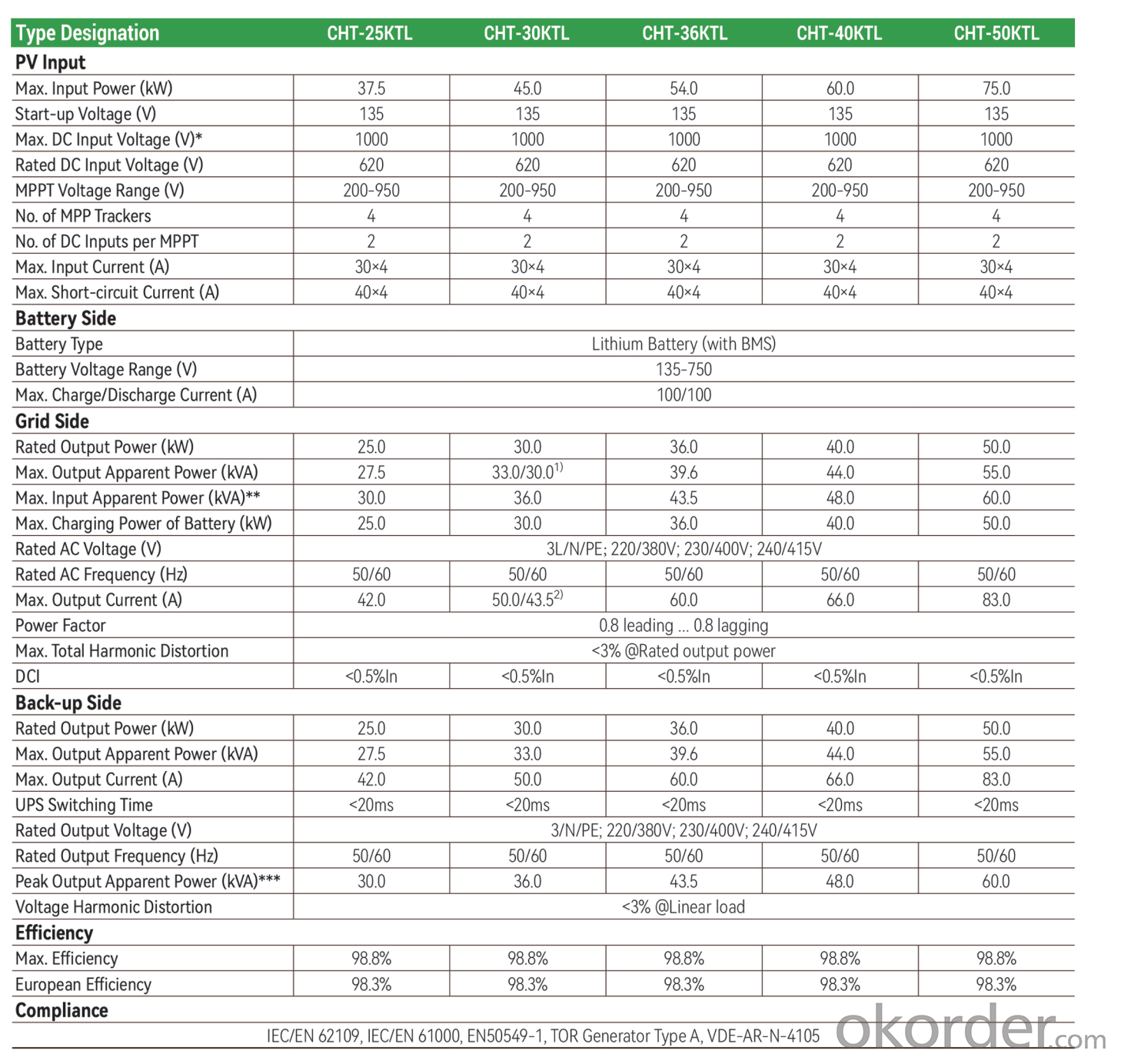
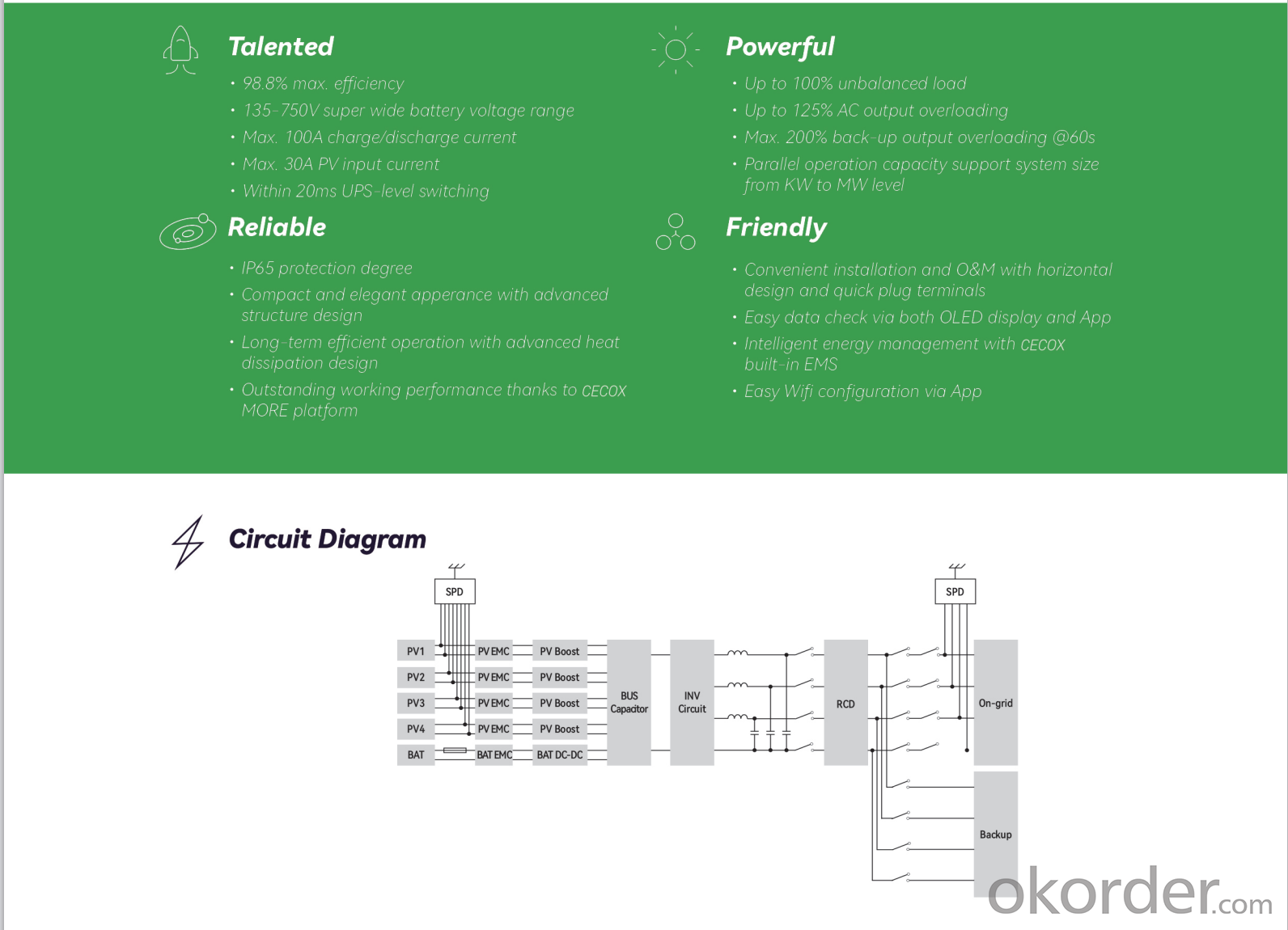
- Q: Can a solar inverter be used with different types of backup power configurations?
- Yes, a solar inverter can be used with different types of backup power configurations. Solar inverters are designed to convert the DC power generated by solar panels into AC power that can be used to power electrical devices and appliances. They can be integrated with various backup power systems such as batteries, generators, or grid connections to provide uninterrupted power supply during periods of low solar generation or power outages. The versatility of solar inverters allows for flexibility in choosing and combining backup power sources based on specific needs and preferences.
- Q: Can a solar inverter be used with a solar-powered EV charging network?
- Yes, a solar inverter can be used with a solar-powered EV charging network. A solar inverter converts the direct current (DC) generated by solar panels into alternating current (AC) that can be used to power electric vehicles (EVs). By integrating a solar inverter into a solar-powered EV charging network, the excess solar energy can be efficiently utilized to charge EVs, reducing dependence on the grid and promoting sustainable transportation.
- Q: Can a solar inverter be used with building-integrated photovoltaic systems?
- Yes, a solar inverter can be used with building-integrated photovoltaic (BIPV) systems. Solar inverters are an essential component of any photovoltaic system, including BIPV systems. They are responsible for converting the direct current (DC) generated by the solar panels into alternating current (AC) that can be used to power electrical devices in buildings. Therefore, a solar inverter is necessary to ensure the seamless integration of BIPV systems with the electrical grid and the effective utilization of solar energy.
- Q: Can a solar inverter be used in areas with high dust and dirt accumulation?
- Yes, it is possible to use a solar inverter in areas where there is a high accumulation of dust and dirt. However, it is important to take specific precautions and maintenance measures to guarantee its proper operation. Over time, dust and dirt can build up on the surface of the solar panels, causing a decrease in their efficiency. This can also have an impact on the performance of the solar inverter, as it relies on the energy produced by the solar panels. To minimize the impact of dust and dirt, it is essential to regularly clean the solar panels. This can be accomplished by using a gentle brush or sponge along with a mild detergent mixed with water. It is important to avoid using abrasive materials or applying excessive water pressure, as this may cause damage to the panels. Additionally, installing the solar panels at an angle and orienting them towards the sun can aid in reducing the accumulation of dust and dirt. Furthermore, some solar inverters are designed with built-in protection against dust and dirt. These inverters typically have IP65 or higher ratings, which indicates that they are dust-resistant and capable of withstanding water jets. Opting for such inverters can provide an extra layer of protection against the negative effects of dust and dirt accumulation. Overall, while it is possible to use a solar inverter in areas with high dust and dirt accumulation, regular maintenance and proper cleaning of the solar panels are crucial to ensure optimal performance and longevity of the system.
- Q: How does a solar inverter handle variations in grid voltage?
- A solar inverter handles variations in grid voltage by continuously monitoring the voltage levels and adjusting its output accordingly. It has built-in voltage regulation and control mechanisms that help maintain a stable and consistent output voltage, even when there are fluctuations in the grid voltage. This ensures that the solar inverter can efficiently convert the DC power generated by the solar panels into AC power that is synchronized with the grid, regardless of any voltage variations in the grid.
- Q: How does a solar inverter prevent islanding?
- A solar inverter prevents islanding by constantly monitoring the electrical grid's voltage and frequency. If it detects a disruption or deviation from the standard parameters, it immediately shuts down or disconnects from the grid to prevent energy from being fed back into the grid during a power outage. This ensures the safety of utility workers who might be working on the grid and prevents any damage to the electrical system.
- Q: Can a solar inverter be used with a solar-powered pool heating system?
- Yes, a solar inverter can be used with a solar-powered pool heating system. A solar inverter is responsible for converting the DC (direct current) power generated by solar panels into AC (alternating current) power that can be used by household appliances or fed back into the electrical grid. In the case of a solar-powered pool heating system, the solar panels generate DC power, which is then converted by the inverter into AC power to operate the pool heating system.
- Q: What is the role of a fault detection system in a solar inverter?
- The role of a fault detection system in a solar inverter is to monitor the performance and integrity of the inverter and solar panel system. It detects and identifies any abnormalities or malfunctions within the system, such as voltage fluctuations, short circuits, or overheating. By promptly identifying and reporting faults, the system helps ensure the safe and efficient operation of the solar inverter, preventing potential damage and maximizing the overall energy generation.
- Q: What are the key factors affecting the reliability of a solar inverter?
- The key factors affecting the reliability of a solar inverter include the quality and durability of its components, such as the semiconductor devices, capacitors, and transformers. The design and manufacturing processes also play a significant role, as well as the overall system integration and installation. The environmental conditions, such as temperature, humidity, and dust levels, can impact the inverter's reliability, along with the quality of the electrical grid and the stability of the solar power generation. Regular maintenance and monitoring are crucial for identifying and addressing any potential issues that may arise, ensuring the long-term reliability of the solar inverter.
- Q: What is the role of a solar inverter in a grid-independent system?
- The role of a solar inverter in a grid-independent system is to convert the direct current (DC) generated by solar panels into alternating current (AC) that can be used to power electrical appliances in a home or building. It also manages the flow of electricity between the solar panels, battery storage (if present), and the electrical grid, ensuring efficient utilization of solar energy and enabling the system to operate independently from the grid.
Send your message to us
Three Phase Solar 25kw 30kw 36kw 40kw50kw high voltage hybrid inverter Best Selling good price
- Loading Port:
- Stock in Panama
- Payment Terms:
- TT or LC
- Min Order Qty:
- 1 unit
- Supply Capability:
- 5000 unit/month
OKorder Service Pledge
Quality Product, Order Online Tracking, Timely Delivery
OKorder Financial Service
Credit Rating, Credit Services, Credit Purchasing
Similar products
Hot products
Hot Searches
Related keywords
